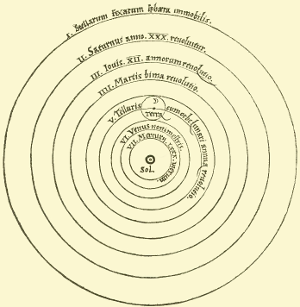Nicholas Copernicus: Founder of Modern Astronomy
Part 2: Making His Mark This was a revolutionary and incendiary document, sure to excite protests in any church officials who read it (since the Catholic Church at that time was going out of its way to maintain Aristotle’s beliefs). But Little Commentary didn’t see the light of day except in the hands of the few friends that Copernicus gave it to. Instead, it served as his blueprint for his later, more famous, work, which took him a lifetime to publish. T 
The “problem” with Copernicus’s theories, according to officials of the Catholic Church, was that the writings of Aristotle, popularized and categorized by the Greek scientist Claudius Ptolemy, put Earth (and, by extension, people) at the center of the universe. People at that time believed that they as a species were second in importance only to God and that, naturally, Earth was second in importance only to God. The Church had made this scientific theory into religious doctrine. To conclude that this theory was wrong was to say that the Church was wrong—something that just wasn’t done in those days. The Church at that time had tremendous power over a great many aspects of people live’s and over the laws and governments of the time as well. The Church could be a great friend, but it could also be a powerful enemy. Saying that Aristotle and Ptolemy were wrong meant that the Church, which supported those ideas, was wrong. This was the first “problem” that the Church would have with Copernicus’s ideas; the second was that if Earth wasn’t the center of the universe, then it wasn’t so special anymore and, by extension, people weren’t so special anymore. It was a slippery slope, and Galileo and other scientists who came after Copernicus zoomed down it in search of scientific truth. Copernicus’s major work, On the Revolutions of the Heavenly Spheres, was not published until the year of his death, 1543, mainly because the perfectionist scientist kept checking and rechecking his data and writing and rewriting his pages. He didn’t live long enough to feel the full firestorm that greeted his ideas. Thus, he is not the heroic figure that Galileo is, standing up to the Church fathers. The young astronomer from Poland is, however, the author of the set of ideas that all of modern science accepts as the true nature of things in the night sky. First page > Early Years > Page 1, 2 |
|
Social Studies for Kids
copyright 2002–2025
David White



 he ideas first advanced in Little Commentary showed a keen understanding of what scientific observation could prove about the universe at large: that what an astronomer saw in the night sky and calculated using common sense and a keen scientific mind could naturally contradict Aristotle’s most basic ideas of the shape and purpose of the universe. (It should be noted here that Copernicus did not have a telescope at his disposal; that hadn’t been invented yet. He made all of his observations with his own eyes.) Copernicus was doing nothing less than advancing the idea that what a scientist observed and tracked and concluded might necessarily be the truth. This might sound like a natural set of conclusions to our modern minds, but it was revolutionary back then, even in a time in which scientific inquiry was encouraged.
he ideas first advanced in Little Commentary showed a keen understanding of what scientific observation could prove about the universe at large: that what an astronomer saw in the night sky and calculated using common sense and a keen scientific mind could naturally contradict Aristotle’s most basic ideas of the shape and purpose of the universe. (It should be noted here that Copernicus did not have a telescope at his disposal; that hadn’t been invented yet. He made all of his observations with his own eyes.) Copernicus was doing nothing less than advancing the idea that what a scientist observed and tracked and concluded might necessarily be the truth. This might sound like a natural set of conclusions to our modern minds, but it was revolutionary back then, even in a time in which scientific inquiry was encouraged.
